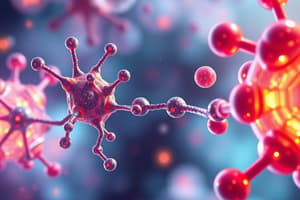Podcast
Questions and Answers
Which type of bond forms between atoms in a water molecule?
Which type of bond forms between atoms in a water molecule?
- Polar covalent bond (correct)
- Nonpolar covalent bond
- Ionic bond
- Hydrogen bond
What determines whether a molecule is hydrophobic or hydrophilic?
What determines whether a molecule is hydrophobic or hydrophilic?
- The structural configuration of the molecule’s functional groups
- The overall molecular weight of the substance
- The types of bonds and their polarity within the molecule (correct)
- The presence of ionic bonds within the molecule
Which of the following statements best describes electronegativity?
Which of the following statements best describes electronegativity?
- It is the tendency of an atom to attract electrons in a bond. (correct)
- It determines the reactivity of an atom in a molecule.
- It measures the strength of ionic bonds.
- It reflects the size of an atom in a compound.
What type of bond is likely formed between two atoms with similar electronegativity values?
What type of bond is likely formed between two atoms with similar electronegativity values?
How do nonpolar covalent and polar covalent molecules behave in water?
How do nonpolar covalent and polar covalent molecules behave in water?
Flashcards are hidden until you start studying
Study Notes
Common Elements in Cells
- Major elements include carbon, hydrogen, oxygen, nitrogen, phosphorus, and sulfur (CHONPS).
- These elements are essential for forming the structures and functions of biological molecules.
Classes of Macromolecules
- Four main classes: carbohydrates, lipids, proteins, and nucleic acids.
- Corresponding monomers:
- Carbohydrates: monosaccharides (e.g., glucose)
- Lipids: fatty acids and glycerol
- Proteins: amino acids
- Nucleic acids: nucleotides
Electronegativity and Bond Types
- Electronegativity refers to an atom’s ability to attract electrons in a chemical bond.
- Differences in electronegativity determine bond types:
- Nonpolar covalent bonds: difference of 0 to 0.4 (e.g., H₂)
- Polar covalent bonds: difference of 0.5 to 1.7 (e.g., H₂O)
- Ionic bonds: difference greater than 1.7 (e.g., NaCl)
Behavior of Molecules in Water
- Nonpolar covalent molecules (e.g., oils) do not mix with water; they are hydrophobic, meaning they repel water.
- Polar covalent molecules (e.g., sugars and salts) dissolve in water due to interaction with water molecules, classified as hydrophilic.
Hydrophobic vs. Hydrophilic Molecules
- Hydrophobic molecules are typically nonpolar and do not interact well with water, avoiding it.
- Hydrophilic molecules are polar or ionic, allowing them to form hydrogen bonds with water.
Water Molecule Structure
- Water (H₂O) consists of two hydrogen atoms and one oxygen atom connected by covalent bonds.
- Hydrogen bonds occur between water molecules, resulting in unique properties like cohesion and surface tension.
Contrast of Bond Types
- Covalent bonds: electrons are shared between atoms; strong and stable.
- Ionic bonds: transfer of electrons between atoms leads to electrostatic attraction; usually form between metals and nonmetals.
- Hydrogen bonds: weak attraction between a hydrogen atom bonded to an electronegative atom and another electronegative atom; important in biological structures.
Studying That Suits You
Use AI to generate personalized quizzes and flashcards to suit your learning preferences.




